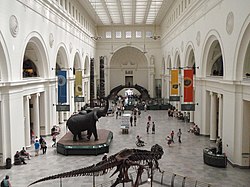
Back المتحف الميداني للتاريخ الطبيعي Arabic Museu Field d'Història Natural Catalan Field Museum of Natural History German Muzeo Field Esperanto Museo Field de Historia Natural Spanish موزه تاریخ طبیعی فیلد Persian Field Museum of Natural History Finnish Musée Field French Field Museum Frisian מוזיאון פילד להיסטוריה של הטבע HE
 The Field Museum's south front | |
| Established | June 2, 1894[1] |
|---|---|
| Location | Near South Side, Chicago, United States |
| Coordinates | 41°51′58″N 87°37′01″W / 41.86611°N 87.61694°W |
| Visitors | 1,018,000 (2022)[2] |
| President | Julian Siggers |
| Public transit access | at Museum Campus/11th Street Red Orange Green |
| Website | www |
Field Museum of Natural History | |
 Stanley Field Hall | |
| Built | 1921 |
| Architect | Daniel Burnham, Pierce Anderson |
| Architectural style | Classical Revival |
| NRHP reference No. | 75000647[3] |
| Added to NRHP | September 5, 1975 |
The Field Museum of Natural History (FMNH), also known as The Field Museum, is a natural history museum in Chicago, Illinois, and is one of the largest such museums in the world.[4] The museum is popular for the size and quality of its educational and scientific programs,[5][6] and its extensive scientific specimen and artifact collections.[7] The permanent exhibitions,[8] which attract up to 2 million visitors annually, include fossils, current cultures from around the world, and interactive programming demonstrating today's urgent conservation needs.[9][10] The museum is named in honor of its first major benefactor, Marshall Field, the department-store magnate. The museum and its collections originated from the 1893 World's Columbian Exposition and the artifacts displayed at the fair.[11][12]
The museum maintains a temporary exhibition program of traveling shows as well as in-house produced topical exhibitions.[13] The professional staff maintains collections of over 24 million specimens and objects that provide the basis for the museum's scientific-research programs.[4][7][14] These collections include the full range of existing biodiversity, gems, meteorites, fossils, and extensive anthropological collections and cultural artifacts from around the globe.[7][15][16][17] The museum's library, which contains over 275,000 books, journals, and photo archives focused on biological systematics, evolutionary biology, geology, archaeology, ethnology and material culture, supports the museum's academic-research faculty and exhibit development.[18] The academic faculty and scientific staff engage in field expeditions, in biodiversity and cultural research on every continent, in local and foreign student training, and in stewardship of the rich specimen and artifact collections. They work in close collaboration with public programming exhibitions and education initiatives.[14][19][20][21]
- ^ "Museum History". The Field Museum. February 23, 2011.
- ^ "Theme Index and Museum Index 2022: The Global Attractions Attendance Report". Themed Entertainment Association. February 1, 2022. p. 75. Retrieved July 30, 2023.
- ^ "National Register Information System". National Register of Historic Places. National Park Service. January 23, 2007.
- ^ a b Bardoe, Cheryl (2011). The Field Museum. Beckon Books.
- ^ Cite error: The named reference
Colemanwas invoked but never defined (see the help page). - ^ Williams, P. M. (1973). Museums of Natural History and the people who work in them. New York: St. Martin’s Press.
- ^ a b c Boyer, B. H. (1993). The Natural History of the Field Museum: Exploring the Earth and its People. Chicago, Illinois: Field Museum.
- ^ Metzler, S. (2007). Theatres of Nature Dioramas at the Field Museum. Chicago, Illinois: Field Museum of Natural History.
- ^ "Museums In the Park". museumsinthepark.org.
- ^ Cite error: The named reference
Alexanderwas invoked but never defined (see the help page). - ^ Cite error: The named reference
Britannicawas invoked but never defined (see the help page). - ^ Cite error: The named reference
fieldmuseum.orgwas invoked but never defined (see the help page). - ^ "Field Museum Traveling Exhibitions". April 6, 2018.
- ^ a b Cite error: The named reference
Niteckiwas invoked but never defined (see the help page). - ^ Shopland, J. M.; Breslauer, L. (1998). The Anthropology Collections of the Field Museum. Chicago, Illinois: The Field Museum.
- ^ Resetar, A.; Voris, H. K. (1997). Herpetology at the Field Museum of Natural History, Chicago: the First Hundred Years. Lawrence, Kansas: American Society of Ichthyologists and Herpetologists.
- ^ Lowther, P. (1995). Ornithology at the Field Museum, pp. 145–161. In: Davis, W. E. Jr. and J. A. Jackson (eds). Contributions to the History of North American Ornithology. Memoirs of the Nuttall Ornithological Club, 12, Cambridge, Massachusetts.
- ^ Williams, Benjamin W.; Fawcett, W. Peyton (1985). "Field Museum of Natural History Library". Science & Technology Libraries. 6 (1/2): 27–34. doi:10.1300/J122v06n01_04.
- ^ Nash, S. E.; Feinman, G. M. (2003). Curators, collections, and contexts: Anthropology at the Field Museum, 1893–2002. Chicago, Illinois: Field Museum of Natural History.
- ^ "Faculty and Trainers | Committee on Evolutionary Biology". evbio.uchicago.edu.
- ^ "University of Illinois at Chicago, Department of Anthropology, Associated Field Museum Faculty". Archived from the original on December 3, 2013. Retrieved December 5, 2013.


